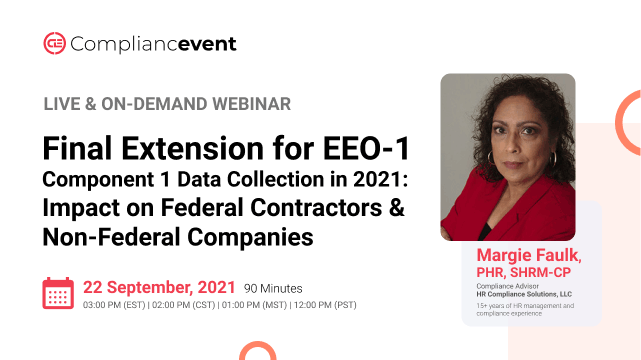- Topics
- Webinars
- Products & Services
Welcome To Biggest Online compliance Platform By LOCGFX Pvt. Ltd.
Human Resource & Payroll
The Equal Employment Opportunities Commission (EEOC) has once again extended the EEO-1 Reporting deadline from August 23, 2021, to October 25, 2021. This is the Final extension!! While this is a relief for many Employers, professionals are responsible for completing the report. It is critical to ensure the report is completed by the final extension.
The extension will be welcomed by employers with outstanding support requests, which often take up to four weeks for an agency response. It will also interest the newly hired employees responsible for completing the report and employees who inherited the task of submitting the report.
The EEOC has a backlog due to a high number of company support requests for reporting mergers, acquisitions, and spinoffs and support requests to obtain user registration and login information.
The additional focus will be on what is the impact if Employers fail to meet the final deadline. There are consequences that will impact federal contractors and non-federal companies.
On April 26, 2021, the U.S. Equal Employment Opportunity Commission (“EEOC”) opened the filing for 2019 and 2020 EEO-1 Component 1 data collection.
Every year, employers with 100 or more employees (and federal contractors with 50 or more employees) must file EEO-1 Component 1 data, which consists of demographic information, such as race, gender, and ethnicity information, of the employer’s workforce by job category. Given that workplace discrimination being an all-time hot topic, this filing always secures the highest points in popularity.
As happened in 2020, the EEOC delayed the opening of the 2019 EEO-1 Component 1 Data Collection due to the COVID-19 public health emergency. Therefore, this year, employers are required to make two submissions instead: one with 2019 EEO-1 data and one with 2020 EEO-1 data!
The EEOC is extending this annual data collection period this year from 10 weeks to 17 weeks, considering the recent update on the deadline, to provide employers additional time to file. It is important to acknowledge that the global COVID-19 pandemic continues to impact workplaces across the country and recognizing that the requirement to submit two years of EEO-1 data is a substantial undertaking.
What is EEO-1 Reporting? Is it mandatory for you to file? How do you file it? When is it due and why is it important? Do 2019 and 2020 data submissions have different procedures? What happens if you don't file it on time?
The deadline for filing your EEO-1 report is right around the corner! It is vitally important that you prepare this form correctly as the Equal Employment Opportunity Commission and the Office of Federal Contract Compliance Programs use your information to determine whether your company should be audited as well as review the data provided to assess complaints of discriminatory practices.
Join Compliancevent this August to learn about the most recent court decision and information available regarding annual government EEO-1 reporting. You will be provided with resources and best practices in migrating from current EEO-1 requirements to the new EEO-1 Form, including Component 1 and Component 2 of the Report and other pertinent information.
This webinar will contain answers to all important as well as often-ignored questions to help you complete the reporting without errors. You will get a clear idea about the new EEO-1 reporting requirements to ensure accurate and timely filing. All registrants will receive free compliance tools to get further guidance on this reporting!
-Why is the extension of the deadline a great relief?
-What was the reason for the deadline?
-Why is the EEO-1 Reporting so Complicated?
-What is the reporting period?
-Who must file it?
-What's the difference between EEO-1 2019 and 2020 data collections?
-Basic and advanced guidelines to fill the form
-Take a step by step overview of the new Online Reporting System
-How do race, ethnicity, and job categories of your workforce impact this reporting?
-How can you effectively comply with confidentiality requirements?
-Learn about the dilemma for Employers when reporting non-binary employees
-How can you practically and legally survey and classify your employees?
-What's mandatory for federal contractors to know and comply with?
-What are the most affordable and legally compliant methods of collecting data from your workers?
-Learn about the specifications EEOC issued for submitting EEO-1 reports, including how and when to file
-Learn how to maximize the EEO-1 Data Collection Fact sheets
-What's the standard you need to follow for collecting demographic information?
-Certification of results, recordkeeping requirements, and more
-How do you collect employee information when your organization has multiple employment locations and when you have remote workers?
-Reporting pay data — what’s new for 2021?
-How about state pay data requirements?
-How do you use your EEO-1 report to find potential pay discrimination?
-What are the state pay data requirements and how can you meet them?
-How to understand the status of the Pay Data Reporting?
-What's the best practice to steer clear of penalties for noncompliance?
-EEOC's and OFCCP's change in enforcement: What employers need to know!
-Business owners and executives
-HR Professionals
-All Employers required to complete EEO-1 Reporting
-Company leadership
-Compliance professionals
-Payroll Administrators
-Managers/Supervisors
-Employers in all industries
-Large business owners
-Small business owners

Margie Faulk is a senior level human resources professional with over 15 years of HR management and compliance experience. A current Compliance Advisor for HR Compliance Solutions, LLC, Margie, has worked as an HR Compliance advisor for major corporations and small businesses in the small, large, private, public, Non-profit sectors and International compliance. Margie has provided small to large businesses with risk management strategies that protect companies and reduces potential workplace fines and penalties from violation of employment regulations. Margie is bilingual (Spanish) fluent and Bi-cultural. Margie’s area of expertise includes Criminal Background Screening Policies and auditing, I-9 document correction and storage compliance, Immigration compliance, employee handbook development, policy development, sexual harassment investigations/certified training, SOX regulations, payroll compliance, compliance consulting, monitoring US-based federal, state and local regulations, employee relations issues, internal investigations, HR management, compliance consulting, internal/external audits, and performance management. Margie’s unique training philosophy includes providing free customized tools for all attendees. These tools are customized and have been proven to be part an effective risk management strategy. Some of the customized tools include the I-9 Self Audit. Correction and Storage program, Ban the Box Decision Matrix Policy that Employers can provide in a dispute for allegations, Family Medical Leave Act (FMLA) Compliance Guide, Drug-Free Workplace Volatile Termination E-Book and other compliance program tools when attendees register and attend Margie’s trainings. Margie holds professional human resources certification (PHR) from the HR Certification Institution (HRCI) and SHRM-CP certification from the Society for Human Resources Management. Margie is a member of the Society of Corporate Compliance & Ethics (SCCE).
Compliancevent Webinar Certification - Compliancevent rewards you with Compliancevent Achievement Certification for unlocking and attending this webinar. It is to acknowledge your participation in this training session and to add more to your professional score.
Compliancevent Courses and Webinars or any Education published "Articles & Materials" strictly follows the standards and guidelines of the Professional Credit / CEU Providers and Well Researched before publishment.
Compliancevent doesn't support any Fake - News, Articles, or Compliance updates; Our Industry Experts are highly verified and recognized, and their Pre-publishment is verified via our experts and fact-checkers.
Sign up now on compliancevent.net. Visit compliancevent.net/webinar to discover a wide range of webinars from industry specialists. Tick on either ‘live webinar’ or ‘on-demand’, and simply click on ‘buy now’ to get enrolled.
You can refer compliancevent to anyone in your social circle. Explore your industry with your colleagues by getting them signed up on compliancevent.net today!
Go for the topic of your keen interest on compliancevent.net. Tick on ‘live webinar’ and get enrolled! Easy registration, transparent transaction.
You can request for an on-demand webinar that records the live webinar for you. After the webinar ends, you will have full access to the webinar’s recording. You can also explore compliancevent offline to order your webinar DVDs, flash drives and transcripts.
If you can’t attend the live webinar, simply go for the ‘on-demand webinar’ for the same price! Now, the live webinar recording will be saved in a cloud storage for you to access anytime from anywhere.
compliancevent offers both hard and soft copies of the webinars. It contains all the highlights as well as comprehensive descriptions of the webinar, so you never miss out a single detail.
After attending the live webinar, your certificate will be emailed to you. You can download it and add more charm to your professional score.
At the end of each webinar, you have the opportunity to interact with your industry experts, where you will get answers to all your queries.
Can’t attend the live webinar? compliancevent has got you covered! You can always switch to the on-demand webinar from your portal. You can also get your hands on the webinar’s DVD/flash drive and transcript. So order them now!
compliancevent brings a variety of options for offline learning. Order your DVDs, flash drives or transcripts now to have a lifetime access to compliancevent webinars. You can also go for on-demand recordings. Download and watch it anytime from anywhere in the world!
